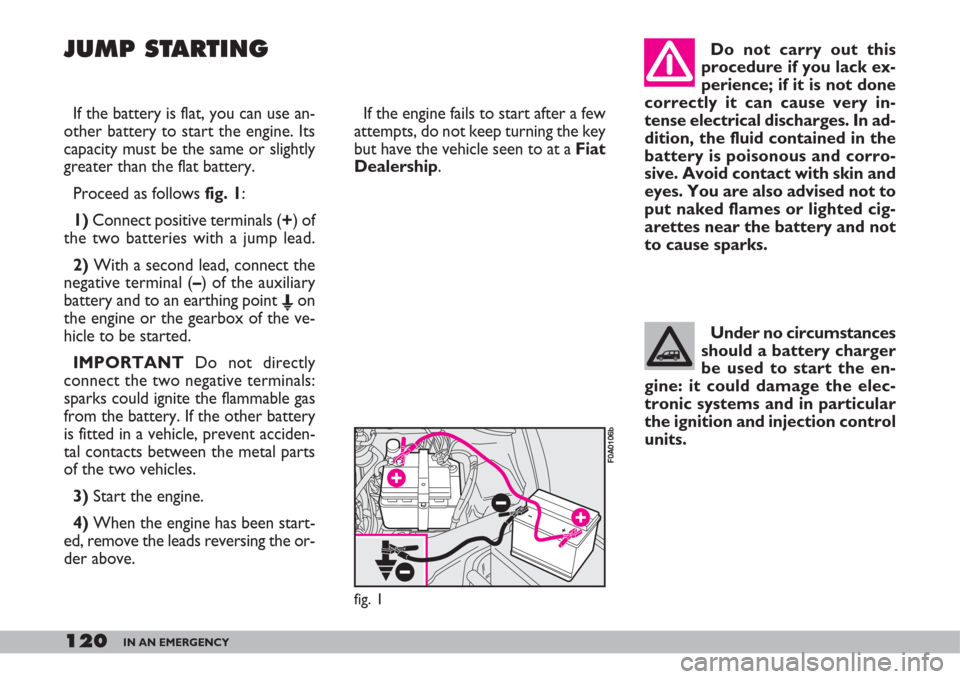Page 100 of 218

99GETTING TO KNOW YOUR VEHICLE
Wiring diagram:
1Sound system mute function.
2Spare.
3Cellular phone input earth signal.
4Cellular phone INPUT signal.
5Dual-purpose speaker on the front
passenger side door (+).
6Dual-purpose speaker on the front
passenger side door (-).
7Ignition switch power (+15).
8Spare.
9Battery power (+).
10Earth.Maximum power to be
applied to the aerial is
20W.
Have the cellular tele-
phone installed and con-
nected to the setup sys-
tem in the vehicle by a Fiat Deal-
ership only. This will ensure the
best results and prevent any
problems which could effect ve-
hicle safety.
Purchase a free-hands kit
which is compatible for
your cellular telephone.
fig. 147
F0A0210b
fig. 148
F0A0211b
Have the cellular telephone and the
connections performed by a Fiat
Dealershiponly.
In Fiat Doblò passengers Transport
versions, use a screwdriver in the
point shown in fig. 147to reach the
ten pin connector. Lift the central tun-
nel cover and remove the connector.
In Fiat Doblò Cargo versions, loosen
the screws shown in fig. 148in the
glove compartment to reach the ten
pin connector. Use a screwdriver in
the pre-cut point and remove the con-
nector.
Page 121 of 218

120IN AN EMERGENCY
If the battery is flat, you can use an-
other battery to start the engine. Its
capacity must be the same or slightly
greater than the flat battery.
Proceed as follows fig. 1:
1) Connect positive terminals (+) of
the two batteries with a jump lead.
2)With a second lead, connect the
negative terminal (–) of the auxiliary
battery and to an earthing point E
on
the engine or the gearbox of the ve-
hicle to be started.
IMPORTANTDo not directly
connect the two negative terminals:
sparks could ignite the flammable gas
from the battery. If the other battery
is fitted in a vehicle, prevent acciden-
tal contacts between the metal parts
of the two vehicles.
3) Start the engine.
4)When the engine has been start-
ed, remove the leads reversing the or-
der above.If the engine fails to start after a few
attempts, do not keep turning the key
but have the vehicle seen to at a Fiat
Dealership.
JUMP STARTING
fig. 1
F0A0106b
Do not carry out this
procedure if you lack ex-
perience; if it is not done
correctly it can cause very in-
tense electrical discharges. In ad-
dition, the fluid contained in the
battery is poisonous and corro-
sive. Avoid contact with skin and
eyes. You are also advised not to
put naked flames or lighted cig-
arettes near the battery and not
to cause sparks.
Under no circumstances
should a battery charger
be used to start the en-
gine: it could damage the elec-
tronic systems and in particular
the ignition and injection control
units.
Page 149 of 218

148IN AN EMERGENCY
FIRST-AID KIT
It is a good idea to keep a fire extin-
guisher and blanket in the vehicle in
addition to the first-aid kit.
The first aid kit can be arranged on
the shelf as shown in fig. 48.
fig. 48
F0A0511b
– In pile-ups on the motorway, par-
ticularly when the visibility is bad,
there is a high risk of other vehicles
running into those already stopped.
Get out of the vehicle immediately and
take refuge behind the guard rail.
– If the doors are blocked, do not at-
tempt to smash the windscreen to get
out of the vehicle. It is made of layered
glass and is very hard. Side and rear
windows are much more easily bro-
ken.
– Remove the ignition keys from the
vehicles involved.
– If you can smell petrol or other
chemicals, do not smoke and make
sure all cigarettes are extinguished.
– Use a fire extinguisher, blanket,
sand or earth to put out fires no mat-
ter how small they are. Never use wa-
ter.IF ANYONE IS INJURED
– Never leave the injured person
alone. The obligation to provide as-
sistance exists even for those not di-
rectly involved in the accident.
– Do not congregate around the in-
jured person.
– Reassure the injured person that
help is on its way and will arrive soon.
Stay close by to calm him/her down in
case of panic.
– Unfasten or cut seat belts holding
injured parties.
– Do not give an injured person any-
thing to drink.
– Do not move an injured person un-
less the following situations arise.
– Pull the injured person from the ve-
hicle only if it risks catching fire, it is
sinking in water or is likely to fall over
a cliff or similar. Do not pull his/her
arms or legs, do not bend the head
and, as far as possible, keep the body
horizontal.